![]()
![]()
![]()
Use LEFT and RIGHT arrow keys to navigate between flashcards;
Use UP and DOWN arrow keys to flip the card;
H to show hint;
A reads text to speech;
127 Cards in this Set
- Front
- Back
|
Why do we marry and what cultural factorsor barriers can impact those decisions?
|
In the US, we marry for _________
Other countries marry for:› Extended family› Creating & raising children› Continuing family linage |
|
|
Restricting Love Terms |
Child marriage – betrothed to marry (ormarried) prior to puberty
Kinship rules – defining who can bemarried Segregation – diminishing cross-sexinteraction Close supervision – supervising Relative freedom – managing the socialenvironment |
|
|
How have marriage rates changed over time? |
Marriage Rates have Decreased |
|
|
what is Changing in marriage today? |
The decline of marriage rates for AfricanAmericans due to high incarceration ratesamong men and higher unemploymentrates is an example of smaller pool of eligibles
- delaying marriage,the average age of marriage today is 27 for women and 29 for men. If you delay marriage, there is moreopportunity for…. › Singlehood › Cohabitation › Nonmarital sex › Nonmarital childbearing -Interacial Marriage -Interfaith Marriage -Same Sex Marriage - Attitudes about marriage (Nonmarital sex,Cohabitation,nonmarital childbearing,shared breadwinning,division of household labor) |
|
|
2 perspectives for decline in marriage |
1. Marriage Decline 2. Marital Resilience |
|
|
Marital Decline |
› Marriage is being threatened by hedonisticpursuit of personal happiness› “Evidence” = Collapse of values inmarriage, which has lead to societalproblems
|
|
|
Marital Resilience |
› Marriages are no weaker than in the past› People are more cautious about enteringmarriage› Problems with family instability are driven byother social problems (e.g., lack of resources)
|
|
|
Homogonous Marriage |
Share certain socialcharacteristics with spouse(e.g., race, age, ethnicity,education, & class)
-When considering education - meetingspouse in college; a way to continuerelationships among “elites” (legacypreferences)
|
|
|
Heterogamous Marriage
|
Don’t share those socialcharacteristics
**We are moving towards moreheterogamous marriages** |
|
|
Anti-miscegenation Laws
|
Lasted at the state level until 1967
Alabama was the last in 2000 › 77% of adult Americans approveBlack-White marriages (from 48% in 1994) |
|
|
Interfaith Marriage |
However, what we see is that coupleswho share similar religious beliefs tend tohave a happier and more satisfyingmarriage
|
|
|
Same Sex Marriage |
How do you think this will impact themarriage rate? Will we see anincrease or a decrease?› There may be an immediate spikein marriages, but it is hard to saylong-term
|
|
|
Civil Union |
* |
|
|
Cohabitation |
Seen as a normal trajectory for some, but for most is still notconsidered a complete replacement for marriage
|
|
|
Is marriage a benefit and to whom?
|
Marriage benefits men more than women |
|
|
His and Her Marriage |
(Bernard, 1972): in some ways men dobenefit more– women have a longer to-dolist (childcare, housework, keeping up witheveryone’s health)
|
|
|
Married people are Happier,have lower depresion, higher self esteem,healthier,financially better off |
* |
|
|
How would you define maritalsatisfaction and success?
|
Stability and quality
These two are not the same thing but theyare correlated You can have a stable marriage and alsohave a low quality marriage |
|
|
Types of long term marriages |
Conflict-habituated
Devitalized Passive-congenial Vital Total |
|
|
What makes a successful marriage, and howhave opinions about this changed over time?
|
makes a successful marriage:
› Faithfulness› Sex› Shared tasks› Income Over the past few decades we have seenchanges in: › Shared tasks (+) › Children (-) |
|
|
Marital Satisfaction Factors |
Relationship with parents (think Attachment Theory)
Quality & stability of parents’ marriage› Intergenerational Transmission of Divorce ~ kids of divorceare more likely to divorce Shared values, goals, and characteristics: more likelyto be happy and stable because it is easier to makedecisions based on your shared values Religious faith & practice: less likely to think divorce isan option; the more religious, the more commitmentand satisfaction Frequency & satisfaction of sex: more likely to report asatisfying marriage when there is frequent andenjoyable sex Satisfaction with gender roles & shared tasks: those withegalitarian attitudes have a higher marital satisfaction |
|
|
Over the last few decades we have seen that fewercouples are endorsing ___________ as an importantelement to having a successful marriage than inthe past.
|
Having Children |
|
|
Three emerging trends |
• Remaining Child Free
• Postponing/Delaying Parenthood • Having fewer children |
|
|
Remaining Child-free |
• Wome -will often times take the child free positionfirst; despite this, women are usually moreambiguous in their stance on having children• who are firstborn or only children and are highachievers
• Men-who want to be child free are typically moreconfident in their decision than women• are more likely to be in egalitarian marriages |
|
|
Delaying Parenthood |
• In 1970, first birth at about 21• Today, first birth at about 25 (Note: Average ages are for women)
• Delayed marriage ≠ delayed parenthood • What we are talking about here is parenthood,independent of marital status Why?• Primarily social reasons• Rising number of 2nd marriages• Increase in the number of womenpursuing higher education andcareers
|
|
|
Social Perspective on Parenthood |
• Pronatalist bias: Values, laws, employment policies,and culture that promote and encourage childbearing• Having kids = good; you’re “normal”• Not having kids = bad; you’re “selfish”
Structural anti-natalism: Values, laws, employmentpolicies, and culture that are detrimental to childrenand committed parents• Having kids = bad; not enough resources• Not having kids = good; helping society |
|
|
Total Fertility Rate |
average number of childrenborn to a woman during her lifetime
• Approximately 2.1 = replacement level In the U.S. we are currently below replacement rate |
|
|
General Fertility Rate |
number of children born per1,000 women ages 15-44 (age group most likely togive birth)
|
|
|
Crude Fertility Rate |
The number of children bornper 1,000 population
|
|
|
What is there to consider when deciding to have children? |
Emotional investment :Parents experience more stress, have lowerpsychological well being, and see declines inintimacy
Energy investment:Loss in sleep Time investment:Devoting time to children can result in lesstime for you, your partner, and your activitiesor hobbies Financial investment: Kids = $$$$But what is the financial investment? • Direct financial costs:• Pre-natal care: Ultra sounds• Birth and hospital stay costs• Formula, Diapers• Clothes • Opportunity costs: the economic opportunities forwage earnings and investments that parents forgowhen rearing children.Financial |
|
|
I would expect that raising a child born in 2013until age 18 (prior to college) costs about
|
More than 200,000 |
|
|
How to have children? |
• The good old fashioned way
• Infertility? Unable to get pregnant after a year of trying. Affects around12% of people; 30% of problems are in men, 30% of problemsare in women, and the rest are either both or unknown • What other options are there? • Assisted Reproductive Technology (fertility treatments) -In-Vitro Fertilization• Eggs are surgically removed andfertilized in a lab and once someeggs are fertilized they are implantthem into the uterus.• In some cases, egg donors are used• About 1/4- 1/3 result in birth Artificial Insemination:Introducing the sperm to the egg without sex Adoption :Around 4% of Americans adopt•Process: Public (through an agency) vs. Private(arranged between adoptive and biological parentswith the help of an attorney- more common) • Type: Closed, Open, Semi-Open • Closed: all information about birthparents is sealed • Open to semi-open: informationis shared about the birth parentsand there may be somecommunication (more common) |
|
|
Transition to parenthood |
• 40% to 70% of couples experience stress, conflict,and a decline in marital satisfaction.• We also see that most parents are actually reallysurprised at how challenging it is
Several factors affect the transition: • baby’s temperament, baby’s sex • parents’ expectations about their baby • the support from kin • marital adjustment, communication skills • father’s parenting involvement • whether the baby was planned |
|
|
What do children need? |
It depends on:
• developmental age • ability Regardless of these factors, children need: Love and nurturance Feel valued Develop autonomy Develop skills valued by society Ability to accept love and give love |
|
|
Parenting Styles |
Diana Baumrind (1966) originally conceptualizedparenting into different styles, which has been one ofthe best ways to study and look at parenting. In 1983,Maccoby & Martin expanded her work on parentingstyles (know this updated version of parenting styles)
There are 4 styles of parenting: discovered through the observation of parents andtheir children Differ based on the varying levels of “warmth”and “control” Warmth: responsiveness Control: demandingness |
|
|
4 types of Parenting |
1. Authoritative- High Control, High Warmth Authoritative-Democratic, choice within limits, warm,intentional or planned parenting,Mutual respect and compassion,Guiding child in a positive way while also settinglimits on behavior |
|
|
4 types of Parenting |
2.Authoritarian-High Control, Low Warmth Authoritarian-Firm, rigid, directive, punitive, reactionary,Unquestioning authority (legitimate),Hierarchy of respect,Little room for compromise |
|
|
4 types of Parenting |
3. Permissive- Low Control, High Warmth Permissive-High warmth/low control,Encouraging, friend-like relationship, Few rules, monitoring, limits; children may set thelimits,kids aren’t held accountable for their actions, and we have seen an increase in the use of this parentingstyle recently |
|
|
4 types of Parenting |
4. Neglectful- Highest level of depression,Least social skills, and Worst academic performance |
|
|
Discipline |
Root Word in Latin: Disciplina = instruction; to learn
Instruction, training; not punishment Discipline happens every moment of everyparent-child interactionWhat is this training intended to produce? Purpose:1. Increases appropriate behavior2. Teaches how to controlimpulsiveness |
|
|
How do we define good parenting? |
-Differs among cultures Differences in opinions on: • Co-sleeping• Breastfeeding for multiple years • Baby wearing (instead of strolleruse) • Mother and child are neverseparated for 40 hours a week vs.many US mothers go back towork shortly after ”Good Parenting” has even changedwithin our own culture over time (fromcolonial America to now) • Emotional distance between parentsand children • Strict; expected unquestionedobedience |
|
|
Parents Primary job is Socialization |
The lifelong process by which weacquire the cultural values and skillsneeded to function as human beingsand participate in society
|
|
|
Parents influence children |
and children influence parents by bidirectional nature of parenting |
|
|
What are some ways in which childrencan impact their parents?
|
Medical conditions & disabilities-Stress, money, and strain associated with this
Temperament-Easy vs. difficult baby (behavior of baby) Sex differences-Marital satisfaction is higher whenyou have a boy; differences inparenting styles; likelihood to divorce |
|
|
What current trends are we seeing inparenting today?
|
In most societies around the world, a highervalue is placed on boys than on girls:
Underlining patriarchal view Financial benefit to having a boy? (thinkabout traditional costs associated with awedding for example) Those outside of “the family” are becomingincreasingly involved in childrearing: Outside agents of socialization Parents are becoming increasinglypermissive; place less emphasis onobedience, control, and parental authority |
|
|
Employed Mothers |
Amount of time spent mothering:
Stay at home moms: 32 hours a week Employed moms: 27 hours a week Employed moms: Still feel guilt,Meet critical judgments from others |
|
|
Fathering |
Industrial revolution transformed fathers’ role
“Good provider” Model continued untilthe 1970’s and 80’s Last 20 years -Men are wrestling withtheir roles as fathers |
|
|
What does it mean for parents to be involved? |
Three-pronged approach to parentalinvolvement:
Accessibility Engagement Responsibility |
|
|
How Do Kids Develop? Freud
|
Psychoanalytic perspective: Unconsciousforces drive our behavior and who we are
3 parts of our personality that drivebehavior: • Id: biological drives and needs forimmediate gratification; acting onimpulse • Ego: rational component of ourpersonality that will balancebetween the need for immediategratification (Id) and the demandsof society (superego) • Superego: “conscience” that refersback to cultural norms to helpguide our behavior |
|
|
How Do Kids Develop? Piaget |
Formal Operation ( 12 Years-Adult)- The children can think logically about concrete objects and can thus add and subtract. The child also understands conservation Concrete Operational (7-12 Years)- The Child uses symbols to represent objects but does not reason logically. The child also has the ability to pretend. During this stage the, the child is egocentric. Preoperational (2-6 Years)- The infant explores the world through direct sensory and motor contact. Object permanance and seperation anxiety developing during this stage. Sensorimotor (0-2 Years) |
|
|
How do kids develop? Cooley & Mead |
Sociological perspective: Can’t form selfconceptwithout social contact with others
• Looking glass self • Role taking: mentallyputting yourself intosomeone else’s role tounderstand the worldfrom their point of viewand anticipate theirresponse to us |
|
|
How do kids develop? Bandura |
Social Learning Theory: Behavior is learnedthrough modeling & reinforcement
|
|
|
Single Parents |
Many TYPES of single parent homesand many PATHS to single parenthood
1. The amount of single parent homes have ↑ 2. More likely to be black children (~40%) 3. More likely to be impoverished & on food stamps 4. Less likely to own home 5. Lower levels of education |
|
|
What else influences childoutcomes?
|
Same sex parents = Very similar to heterosexualparents
1 in 3 lesbian couples have child(ren) 1 in 5 gay couples have child(ren) Little or no differenceamong children Psychological well-being Performance in school Substance abuse Delinquency Early sexual experiences |
|
|
Grandparents as Parents |
How do grandparents become parents?
Most often because of parental substance abuse but also:incarcerated parents, physical/mental illness, employmentchallenges, child abuse or neglect, desertion, or death Strengths-Minimize trauma by providing continuity & family support Challenges- Physical exhaustion Physical or mentalhealth problems Financial challenges “No choice” |
|
|
Two Career Marriages |
Different than two-earner marriages: Careersdiffer from jobs in that they hold the promiseof advancement and demand a high degree ofcommitment.
Two-career families often outsource domesticwork and are likely to employ an in-homecaregiver. |
|
|
Working Parents |
Fathers are more likely to feel that they don’t spendenough time with children…but mothers are more negatively affected when theyperceive that they spend too little time with children
Mothers curtail employment when they experiencehigh work-family overload while fathers will setaside the family obligations |
|
|
Childcare |
1. Mothering approach - The couple preferredthat the wife care for the children.
2. Parenting approach - Family care was sharedby parents, who structured their work to thisend. 3. Market approach - Career oriented coupleshired others to care for children (nanny, daycare, cousin). Around 60% of children under age 5 are insome sort of childcare |
|
|
Is childcare harmful? |
Children who spent more time in childcare (30+hours) had:
1. More aggressive behavior -Still within normal range ,Differences disappear by 3rd grade 2. Poorer work habits & social skills- Differences were minimal and within normal range 3. Higher language and other academic skills |
|
|
|
* |
|
|
Quality of Childcare= Most Important |
High quality: better outcomesthan those who are not inchild care
Low quality: poorer outcomesthan those not in child care Quality childcare can costaround $10,000 per year perchild |
|
|
Work-Family Conflict |
A form of tension under whichpeople feel that the pressures from paid work & familyroles are incompatible in some way
|
|
|
Role Overload |
Too many commitments, toolittle time
|
|
|
Spillover |
Demands of one work sphere carry over intothe demands of another work sphere
Cohesive families (togetherness/support)= more positive family-work spillover Gender: satisfaction with division of householdlabor = positive spillover for women satisfaction with couple relationship= positive spillover for men |
|
|
Routine Labor |
Women do more Routine Household Labor
Preparing meals, washing dishes, cleaning up, changingdiapers, etc. Repetitive & nondiscretionary |
|
|
Occasional Labor |
Men do more Occasional Household Labor
Mowing he lawn, fixing the shutters, etc. Time-flexible & discretionary |
|
|
Children and Household Labor |
Help around the house:
Low-income & single parent families rely on this(especially daughters) “parentified children”/“mini-moms” Socialization: Gender roles, values about hard work and money earned Child housework & gender: Young children’s housework is less gendered (based more onability and developmental age) Teens – girls do more routine labor, boys do more occasionallabor |
|
|
When People work matters |
Working “the night shift” is related to…
more distress (esp. for women) higher depression lower marital quality |
|
|
Florida minimum wage (2015) = $8.05/hour
$322/week BEFORE taxes $1,481/month BEFORE taxes $17,774/year BEFORE taxes Family of 3 poverty threshold (2014) = $18,284 |
* |
|
|
Living Wage |
minimum income necessary for a workerto meet their “basic” needs
Home, cloths, food, utilities, transportation, healthcare Based on the community one is in How much housing costs & other costs associated with living in thatcommunity |
|
|
Second Shift |
Term describing domestic workemployed women must performafter coming home from a day onthe job (can also apply to menfor those in relationships whoshare labor)
Hochschild (1989) estimatedthat the unpaid work was aroundthe same amount as an extramonth of work each year More enjoyable when shared byboth partners |
|
|
GENDERED DIVISION OF LABOR:
3 Perspectives |
Time–Availability Perspective:
Division of labor is determined by 1. Needs of the home (e.g., # of kids) 2. Each partner’s availability to perform household tasks(e.g., hours spent in paid work) |
|
|
GENDERED DIVISION OF LABOR: 3 Perspectives |
Relative Resources Perspective:
The spouse with the most resources has the most power in therelationship. Resources (money, education, experience etc.) = bargaining power Men will resist doing “feminine tasks” when their status as aprovider is being threatened |
|
|
GENDERED DIVISION OF LABOR: 3 Perspectives |
Doing gender:
– Ingrained by society Gender roles exhibit powerful norm on what we see as normative Takes gender values, identities, and expectations into account “women’s work” and “men’s work” Gatekeeping? - Women may be reluctant to give up control ofhousehold tasks Ex. You hate doing laundry but what you hate more is how your significantother folds the laundry so you end up doing it |
|
|
Crisis |
critical change/event that disrupts thefunctioning of one or more family members
|
|
|
What is the leading cause of death? |
It is Unintended Injury |
|
|
Crisis |
Can be negative or positive
Can be abrupt or slowly evolving Abrupt: unexpected, can not predict Slowly evolving crises typically arise fromcurrent stressors |
|
|
Stressors |
Individual, family, or community
Situational, transitional, or cultural Isolated or cumulative (pile-up) Acute (short term) or chronic (long term) Volitional (stress that is sought out) ornonvolitional Normative (e.g., having a baby) or nonnormative(e.g., having a baby with adisability) |
|
|
What are the 10 most common stressors? |
1. Finances and budgeting
2. Children’s behavior 3. Insufficient time as a “couple” 4. Lack of shared responsibility in family 5. Communication with children 6. Insufficient time for “me” 7. Guilt for not accomplishing more 8. Relationship with spouse 9. Insufficient family “play time” 10. Overscheduled family calendar |
|
|
Three phases of the General Adaptation Syndrome:
|
1. Alarm reaction -Brain perceived stressor
normal state of balance or homeostasis is disrupted 2. Resistance-Body continues to battle the stressor by maintaining high alert 3. Exhaustion-Can lead to depression, fatigue, headaches, anxiety, and eating and sleeping problems etc. |
|
|
Predictable pattern of family crisis
|
Phase 1 – the event
Phase 2 – disorganization Phase 3 – reorganization |
|

|
* |
|
|
The ABC-X Model |

|
|
|
Applying ABC-X |
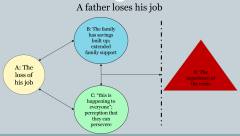
|
|
|
Double ABC-X |

|
|
|
Intimate Partner Violence (IPV) |
IPV: violence between those who are physically andsexuallyu intimate Physical, economic, sexual or psychological abuse 2 million injuries and 1,500 deaths annually
This graph shows that for those who experience IPV, a little over70% experience their first victimization before age 25
|
|
|
Types of IPV |
I want you to know the three types (Johnson, 2008); this isthe updated version
Situational couple violence Intimate terrorism Violence resistance Stalking/cyberstalking |
|
|
Types of IPV: Situational Couple Violence |
Most common - about 1 in 8 couples experience SCV; recognized by one partner(either man or woman) lashing out at the other after an escalation from verbalconflict; can be isolated or early sign
|
|
|
Types of IPV: Intimate Terrorism |
perpetrated by mostly men & more likely to cause injury or PTSD; recognized byphysical, psychological, or sexual abuse used to control the other partner
|
|
|
Types of IPV: Violence Resistance |
self-defense — most likely women; may be a response to being with an intimateterrorist and it may eventually lead to the female leaving
|
|
|
Stalking/Cyberstlking |
Unwanted acts that in isolation are not seen as abusive butwhen taken together they become a form of mental abuse
Can take many different forms: Unwanted phone calls and messages, unwanted letters and emails,giving unwanted presents, showing up all the time when it isn’twanted, and following and spying Which is most prevalent? Unwanted phone calls and messages but now that technology hasan even greater impact, cyberstalking is on the rise (includingGPS, listening devices, e-mail, IM) |
|

|
* |
|

|
* |
|
|
Consequences of IPV |
Psychological and physical effects: Depression, anxiety, poor sleep, low-self esteem, poor physical health
Psychological and physical effects :Depression, anxiety, poor sleep, low-self esteem, poor physical health Victims of IPV are more likely to participate in riskybehavior:Unprotected sex, drugs, alcohol use |
|
|
Coping with Violence |
Women often stay in abusive relationships because ofsomething referred to as learned helplessness:
-A psychological condition of having low-self esteem, feeling helpless,and having no control -Caused by repeated abuse and the tactics that abusive partners use -Blaming others, inducing shame, lowering self-esteem, isolation, financialdependence Studies indicate that women do eventually leave, It’s a process |
|
|
Child Abuse |
an attack on a child that results in injury andviolates social norms
An estimated 700,00 children were the victims of child abuse in 2011 80% of the time the abuse is perpetrated by the mother or father 71% is neglect |
|
|
Types of Child Abuse |
Neglect-Failure to provide basic needs, Includes psychological/emotional needs
Physical abuse Sexual abuse-Inappropriate sexual behavior with a child for sexual gratification Psychological or emotional maltreatment- Verbal, mental, or psychological abuse that destroys a child’s selfesteem |
|
|
Consequences of Child Abuse |
Psychological:
Impacts attachment Mental and emotional health Social difficulties Behavioral Delinquency and criminality Alcohol/drug abuse Physical health Impaired brain development (failure to thrive) Poor physical health Suicide Ideation(recall leading causes of death among adolescents) |
|
|
Explanations for Violence Among Intimates
|
Micro-level explanations
The intergenerational transmission of violence-We learn our behaviors, including violence, by watching others ,These individuals could have witnessed abuse between his/her parents or wasthe victim of abuse themselves .An individual is more likely to abuse when both of their parents was violent asopposed to only one ,But people are resilient and a majority (80%) of those who witness violencegrowing up do not become violent in their own relationships Stress Explanation -Families who experience a large amount of stress are more likely to abusetheir partners and children (because of unemployment, poor health, or financeissues); the stressors exceed their available resources and this frustration andtension can cause violence , In one study (Straus), for every stressor listed by a family member the odds ofabuse in the family grew |
|
|
Explanations for Violence Among Intimates |
Micro-level explanations:
The intergenerational transmission of violence Stress Explanation Macro-level explanations: Patriarchy-Violence occurs more often in cultures where men are the more dominant sex Cultural norms supporting violence-Many feel that it is okay to hit their child for misbehaving, but where is the linedrawn? In some moments the lines may be crossed Norms of family privacy-Violence occurs in families that tend to be socially isolated and many are reluctantto intervene because violence is a private matter ,When a family is socially isolated they do not have the social connections to helpdeal with stressors and therefore build up this stress and anger, leading to violence |
|
|
Power and Control |
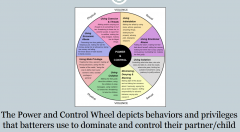
|
|
|
California Family Law Act of 1969
|
No-Fault Divorce
Introduced grounds of divorce that do not requirefault to be attributed to either party through aconcept called Irreconcilable Differences |
|
|
CALCULATING DIVORCE RATES
|
1. Number of divorces per year
2. Crude divorce rate # divorces per 1000 population (includes allpeople, including those who are not at risk fordivorce- children, unmarried persons etc.) 3. Refined divorce rate # divorces per 1,000 married women over 15 yrs. of age |
|
|
1. Number of divorces per year 813,862
2. Crude divorce rate 3.2 divorces per 1,000 people 3. Refined divorce rate 16.9 per 1,000 married women 1.69% per year |
Since we see a decline in divorce, is it going away?Not really…The rate of marriage has also been declining; in turn, thedivorce rate declines with it. Think of divorce in thecontext of marriage |
|
|
Why do couples divorce? |
Communication (31.8%)
Alcohol/Drugs (21.5%) Jealousy/Untrustworthy (21.5%) Extramarital Sex (20.6%) Incompatibility (16.8%) Role Conflicts (16.8%) Lack of Family Investment (15%) Financial/Work Issues (15%) |
|
|
IS DIVORCE THE KEY TO HAPPINESS?
|
One year after separation people were found to be less happy, butin one year after the divorce, people were happier than they hadbeen while married (Gardner & Oswald, 2006)
A couple could report the lowest marital satisfaction, yet, if theydo not divorce, five years later 2/3 of those unhappily marriedcouples describes themselves as “very happy.” Those thatdivorce do not report themselves as very happy later (Waite,2001). Emergent themes from this research: Marital Endurance Ethic - couple was able to outlast their problems Marital Work Ethic - couple was working harder to fix things Personal Happiness Ethic - “I will be happy even if things aren’tgoing well” |
|
|
Experiencing Divorce |
Pre-Separation: think about being freefrom the marriage but also feel sadabout those thoughts. At this point thecouple may continue on with things asnormal
|
|
|
Experiencing Divorce |
Early Separation: Couple beginsdiscussing the logistics of the separationwhowill move, finances, parenting etc.Often many will actually separate beforethe divorce~ in some states this is required
|
|
|
Experiencing Divorce |
Mid-Separation: facing the reality ofliving apart. Some may get back togetherat this point (which can lead to a laterdivorce because of the choice to staytogether out of necessity)
|
|
|
Experiencing Divorce
|
Late Separation: Figuring out your ownlife as a single adult. Deciding to officiallydivorce or not. Couples may separate,reconcile, separate again, then divorce…We see that those who separate are morelikely than not to divorce
|
|
|
Stations of Divorce |
Emotional -Can involve withholding positiveemotions and communications fromthe relationship
The stress from the divorce can leadto physical and mental health symptoms(depression & anxiety) especially for menbecause of a possibly smaller support network Legal-Dissolution by the court Average cost of $15,000 each Divorce mediation: trying to settle/agree on terms outside of thecourt with a third party (therapist/trained mediator) who helps withnegotiation Cheaper option When this process is more contentious it lasts longer |
|
|
Stations of Divorce |
Economic -The economic toll is usually much larger for women 1 in 5 women become impoverished and 1 in 13 men impoverished Why? Functionally, after a divorce men are more likely to becomesingle whereas women become single mothers
Community -Rupture of relationships and changes in the social network (friends,work, religious organizations etc.) Psychic-Regaining psychological autonomy; sense of what it is like withoutpartner and beginning to let go Co-parental-Let’s focus in on this station a little bit more |
|
|
Co-Parental Divorce |
Custody:
Physical; Legal Shared/Joint; Sole Best Interests of the Child |
|
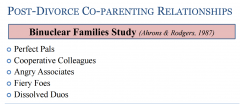
|

|
|
|
IS THERE A SUCH THING AS A“GOOD DIVORCE”?
|
So which is it?
Cooperative Colleagues (38%) v. Bad Divorce (53%) It takes time (as patterns stabilize): Ahrons & Rodgers (1987) looked at fairlywell-established post-divorce relationships;Ferraro, et al (in press) examined theserelationships very close (within 6 months) ofthe time of divorce What we see is patterns of behavior and relationships typically stabilizewithin about 2 years after a divorce (Maccoby & Mnookin, 1992) This means that the process is fluid, and relationship dynamics changeover time after a divorce This does not mean all divorces can reach the “Good Divorce” Can be aided through the formation of a binuclear family |
|
|
WHAT “CAUSES” THE CHILD TOHAVE PROBLEMS AFTER DIVORCE?
|
Life stress -Accumulation of stressors
Parental loss-Between 15-40% of kids have not seen their biological parentover the course of the previous year Parental adjustment -How the parent adjusts will influence the child’s adjustment Economic hardship Interparental conflict-Are the children involved in the parents disputes? Have theybecome a messenger for the parents (often referred to astriangulation)? Family Instability |
|
|
Intergenerationaltransmission of divorce
|
Pattern of divorce
Modeling of relationshipbehavior Intergenerationaltransmission ofsocioeconomic risk |
|
|
Black couples = Most likelyto divorce
|
Hispanic & Asian couples = Least likely to divorce
|
|
|
Macro Level Factors of Divorce |
1. Level of Socioeconomic Development Developed countries = higher divorce rates
2. Religion Stronger religious presence = fewer divorces 3. Divorce Laws Recall our discussion of no-fault divorce 4. Women’s Status & Employment Looking at traditional economic dependence of women on men 5. Attitudes Towards Divorce Is there any stigma attached to divorce? |
|
|
Compared to children in intact two parentfamilies, children that grow up instepfamilies
|
have lower academic achievement
have lower self-esteem have higher depression and anxiety have higher rates of drug and alcohol abuse are more likely to get in trouble at school, getarrested, and experience a teen pregnancy |
|
|
Siblings – Share both biological parents
Half-siblings – Share one biologicalparentStep-siblings – Not biologically related;parents are married to each other Residential v. non-residential Mutual children – Born to the remarriedcouples |
* |
|
|
Blended Families |
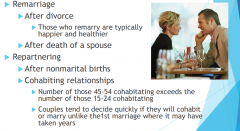
|
|
|
It is suggested that a stepparent eases their wayinto the parenting role by beginning with a stylerevolved around high warmth and low control
|
As time goes on the stepparent should have some inputon rules and consequences while the biological parentis still “in charge” of most of the interaction
Once a healthy relationship is established with the childrenand he/she is seen as a parental figure, he/she can take amore prominent role in parenting and be high in warmthand control - IT WILL TAKE TIME - expectations can varyfrom person to person, from family to family |
|
|
Stages of Step family Integration ( can take 4-12 years) |
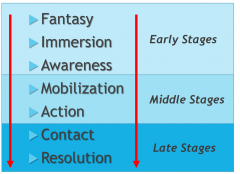
|
|
|
Fantasy - yearn to heal the pain from the“divorce/death” Parents will often think that the new relationship will makeeverything better Kids believe parents will still be able to get back together
Immersion – faced with a new reality Stepparents receive a lot of negative interaction from children Stepparents will often think that this conduct is their own fault Awareness – begin to see patterns develop Give up the fantasy begin to really get to know your new familymembers as a part of your new family Mobilization – people begin trying to hold their ground Small, petty fights Often an “airing of grievances” Negotiating patterns of interactions |
Action – negotiating new agreements Establish more stable boundaries that will inform familyfunctioning at later points This is a critical period for boundary establishment Contact – the stepparent role is established and refined Patterns established in the action stage are instituted The marital relationship can finally become a source ofsupport
Resolution – acceptance of what the stepfamily is There is now stability in roles, responsibilities, andrelationships |
|
|
Stepfamilies Face Unique Issues
|
Come about from loss Divorce or death
Establishing Roles Altering previous roles and accepting new roles Navigating “Undeveloped Institution” Legal rights Dealing with Ex-partner(s) Developing stepparent-child relationships Child Hostility Loyalty Conflicts Financial obligations From the first marriage and now stepparent roleambiguity regarding finances and finances for children |
|
|
What matters more forHealthy Child Development?
|
Family Structure- • Living with a stepparent • Visiting biological parent or Family Environment- • Quality of familycommunication • Quality of family relationships • Extent to which children aremonitored |

